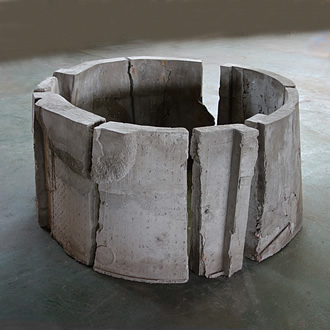Kyklos
2013
The Greek word kyklos means circle, wheel. The art of Tomáš Polcar is linked with the circle in both content and form. Polcar repeatedly works with it as a shape, phenomenon or chain of circumstances, always developing and expanding new ideas. The project Kyklos consists of three cyclically interrelated series.
Polcar first discovered the possibilities of the circle at the start of his Slavětín period, living as he does close to the repeating seasons of the year and amidst cyclical time. He abandoned the city, media campaigns and new media. With the flow of time, his thoughts gradually begin to focus inward, away from the outside world and towards what is essential. It is a subject he has remained with for a long time. He is no mass-producer of art; his works emerge slowly and exclusively by his own hand; he is not a conceptual artist who hires others to finish his ideas for him. His journey along the road of interconnected circles is presaged by a group of black-and-white paintings entitled Knot (2007). The actual exhibition project Kyklos consists of three series: Decay Engenders Life (2008) relates to the landscape and its flowing within the eternal cycle of changes. Atomos (2010) looks at the circle as a perfect Platonic form and thus a fundamental shape from which surrounding entities and relationships are derived. Soma (2012–2013) and the sub-series Arché work with the shape of the honeycomb and focus on the perfection of its form, the latticework it creates, the relationship between the part and the whole, birth and decay, fullness and emptiness.
In his art, Polcar works with his experiences from the world and with his worldviews. Through the language of the paintings and sculptures in his interrelated series, he conveys his searching in the fields of philosophy, spirituality and the natural sciences. He finds excitement in the idea of combining materials and spiritual principles or in the concept of “what is down is also what is up”; he is enchanted by the relationship between microcosm and macrocosm. He resists the temptation to become an “expert” in these fields, and does not attempt any visual metascience. His associations remain consistently painterly and sculptural. His tangible, earthy idealism simply expands upon old and new truths as it sees fit.
© Lucie Šiklová


